How Big Does a Black Lab Terrier Mix Get
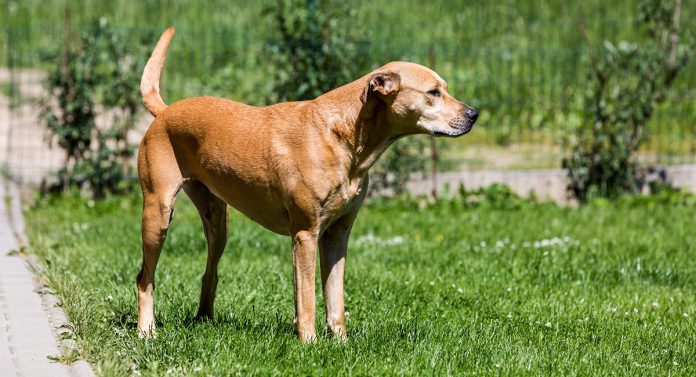
There are many different Lab Terrier mix breeds. In this article we will look at some of the features that Lab Terrier hybrids have in common. And we'll look in detail at several of the most popular Terrier Lab cross breeds today.
We'll help you decide if this is the right pet for you. And show you how to raise your mix breed puppy to be a happy, healthy member of the family.
What is a Lab Terrier Mix
The friendly Labrador Retriever is a sweet-natured, intelligent, sociable dog who is a definite people-pleaser. It's not hard to understand why this athletic, handsome dog is the most popular breed in the US. Equally lovable but in stark contrast in terms of temperament and appearance, are the diverse array of dogs in the Terrier group. This is a varied group, but they do have some general traits in common. Terriers are a feisty lot, with spirited personalities that don't mind a tussle or two, love digging and are quite vocal. They also make loyal, loving, pocket sized pets.
So what happens when these two different breed types combine? In reality it's possible for a Lab and Terrier mix to get any aspect of either parent, and even littermates can have vastly different personalities.
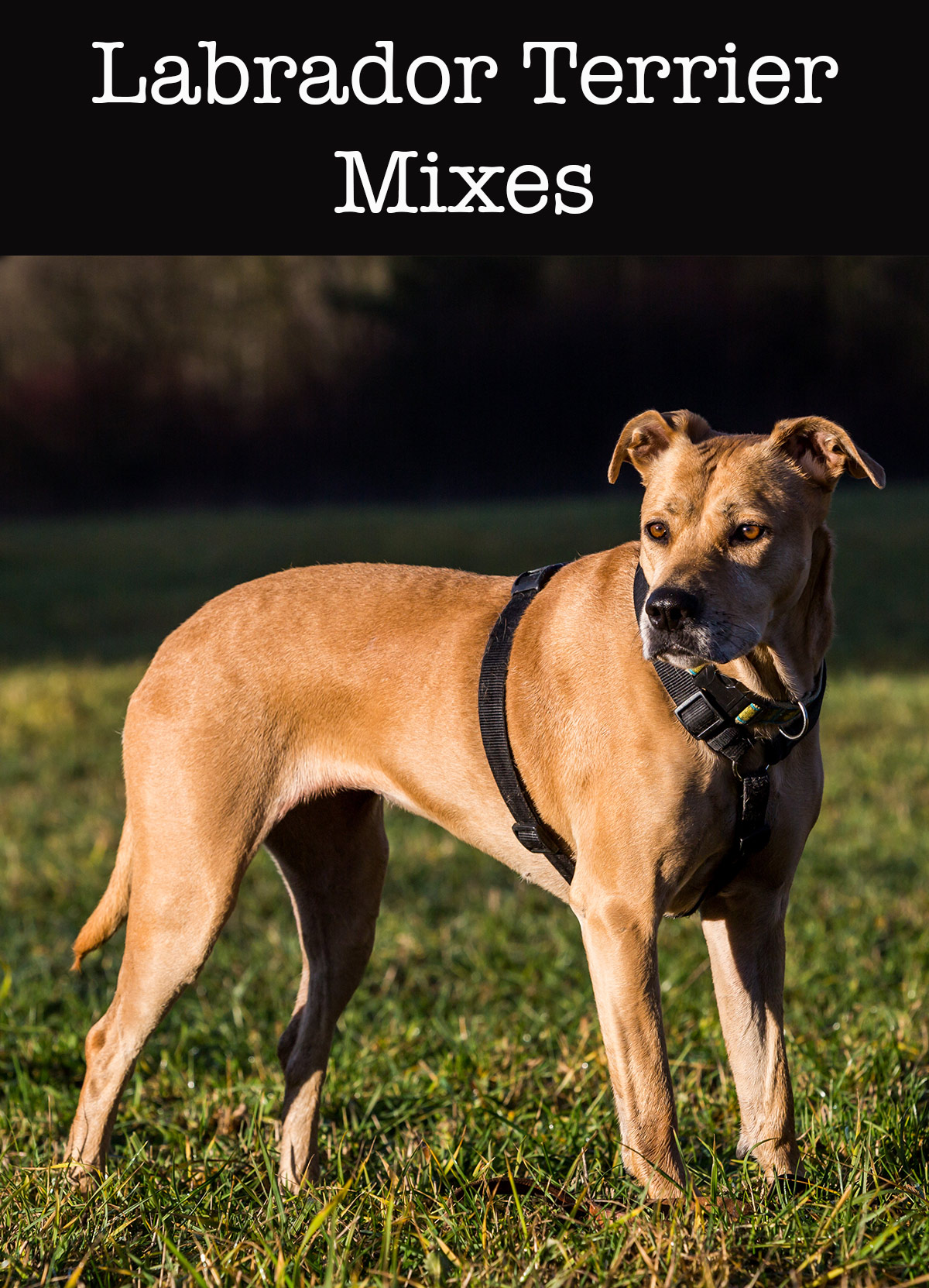
Are you thinking of bringing a Lab Terrier mix dog into your home as a pet? If so, we've gathered together some useful information for potential Lab and Terrier mix owners. Let's start our exploration at the beginning, and what better place to begin than with the very conception of the unique Lab x Terrier cross!
Terrier Lab hybrid possibilities!
As we've mentioned, the Labrador Terrier cross breed will have some of the traits and characteristics of each parent. The tricky part is predicting how these characteristics will emerge. In fact, no responsible breeder will guarantee the personality of any mixed breed dog.
It's simply impossible to determine beforehand how a blend of two unique gene pools will merge and reconfigure into an individual pup. The best anyone can do is consider each breed in turn, and realize that a cross breed canine will be a singular combination of several possibilities. The best of both breeds, the worst of both breeds, or a glorious mashup of the two! With this in mind, let's take a closer look at both the Labrador Retriever and the Terrier pure breeds.
Overview of the Labrador Retriever breed
Labs are a medium size dog with an impressive energy level. The friendly, smart-as-a-whip Labrador Retriever breed originated from hunting stock in Newfoundland, Canada. There they enjoyed success helping fishermen with their arduous, labor-intensive work.
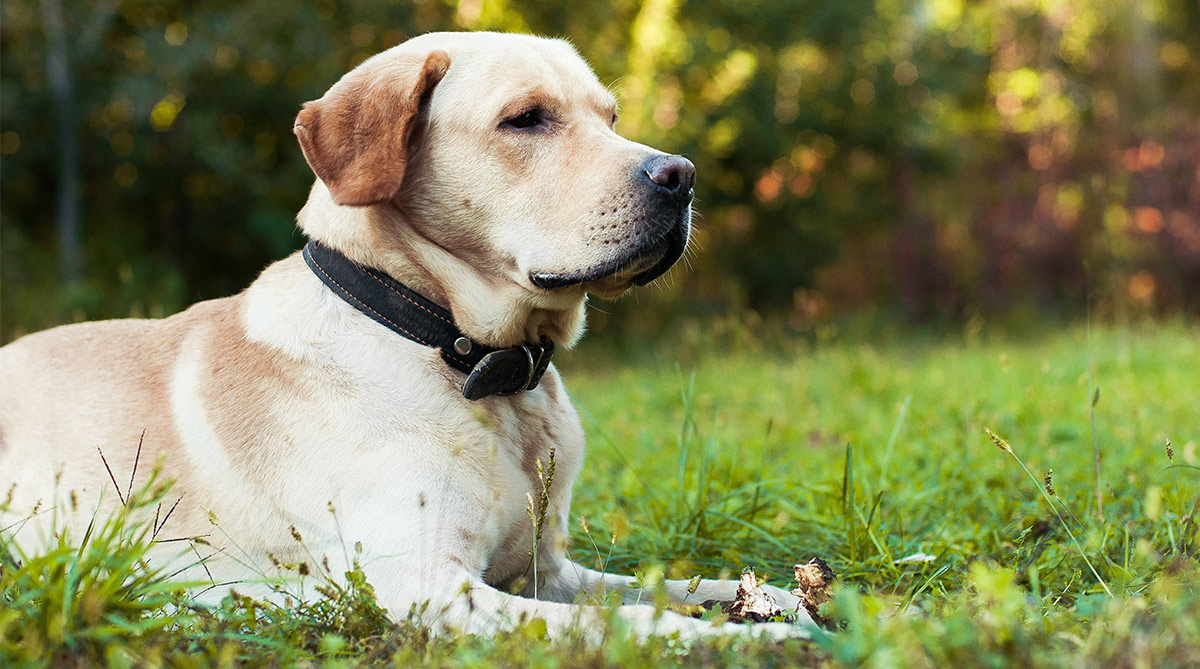
Today a high canine IQ combined with a natural people-pleasing personality makes Labs go-to dogs for search-and-rescue and law enforcement work. As well as being a popular choice for service dog duty.
Labs love everybody, or so it seems, and they make good pets for children and families. You shouldn't expect a loving Lab to be a ferocious guard dog. It's just not normally in their nature! Labradors have beautiful coats are come in three distinct colors: yellow, black, and chocolate. Their "all-weather" fur is both thick and short. Given all of their positive qualities, it no surprise that Labs are an enduringly popular pet breed.
Overview of the Terrier breed
There are several breeds with the Terrier group. These include the Rat Terrier, Bull Terrier, American Staffordshire Terrier, Staffordshire Terrier, Fox Terrier and Border Terrier.
It's believed that the majority of terrier breeds originated in Ireland and Great Britain. And a recent study found that dogs from within the hunting group originated in 19th century Europe.
Modern terriers are commonly grouped according to their function (such as hunting) or size. Dogs from individual groups vary greatly in size, from around 2 to 3 pounds all the way up to 50 pounds and more. We'll explore these, and other, individual Terrier differences in more detail later.
What many Terriers have in common is a history steeped in animal control (killing vermin such as rats, etc.) and herding. Because their DNA is steeped in hunting and killing, terriers aren't often tempted to back down from a real or perceived threat. They have a bold streak in their personality and a dash of fearlessness that can sometimes get the better of them.
However, on the whole Terriers are quick learners capable of getting along well with children when given the proper positive and supportive training. They are also very loyal pets, and great fun to exercise, train and relax with.
Popular Labrador Terrier Mixes
There are many, many cross breed combinations possible between Labs and Terriers. Here we're going to explore several of the most fascinating cross breeds.
Rat Terrier Lab mix
The handsome, small to medium size Rat Terrier is a companion animal that is always game for his next adventure. He has tons of energy and loves being in motion. Being a couch potato or purse dog is just not in his DNA! But the Rat Terrier loves to please his humans so he should take well to consistent and supportive training methods. Early socialization and training should render him a good companion for children. Although he should not be left alone with other dogs.
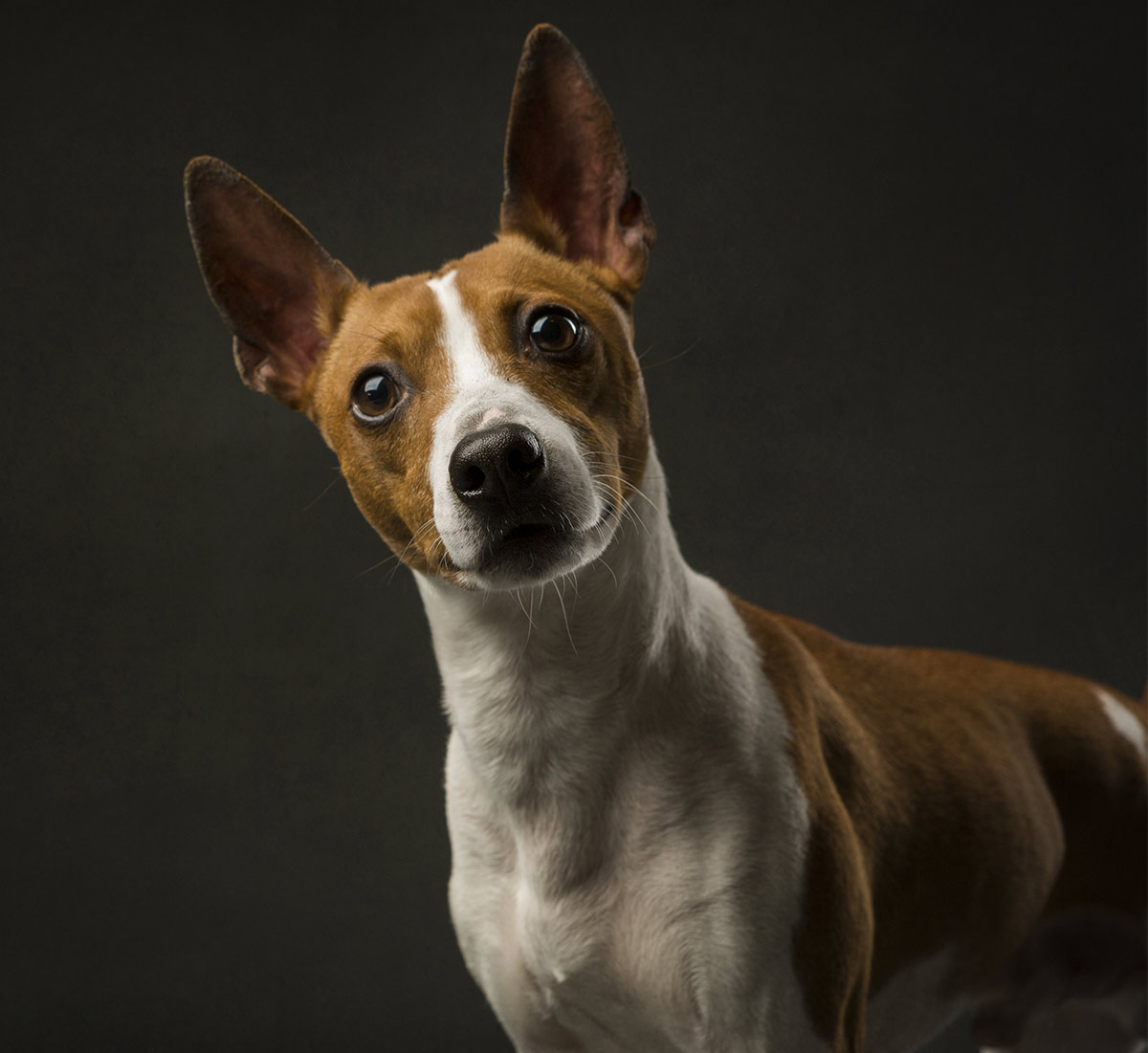
The Rat Terrier's lean little body is covered in a short, tight, dual-colored coat (that sheds seasonally). Colors that include black, red, tan, apricot and blue (sometimes in combination with white).
Rat Terriers are a relatively healthy group, but issues such as heart and eye disease, patellar luxation, and hip dysplasia have been known to crop up. The latter two conditions are common among Labs, so it is important to have your pup tested for these issues.
This compact Rat Terrier comes in a miniature size ranging from 10 to 13 inches as well as a standard size of 13 to 18 inches. Their typical weight range is from between 10 to 25 pounds, and life span varies between 12 to 18 years on average. When you mix a Lab with a Rat Terrier the resulting pup could grow anywhere between these two sizes, and reflect any traits of either personality.
Bull Terrier Lab mix
The Bull Terrier is a lively dog that must have an outlet in order to stave off boredom and any subsequent destructive behavior. Bull Terriers are loyal dogs but giving him other dogs as canine siblings is not recommended. In addition the Bull Terrier can sometimes display a "bratty" stance with his humans. Therefore it's lucky for the plucky Bull Terrier that he is highly trainable. And with positive and supportive behavior management training he can learn to polish up his manners.
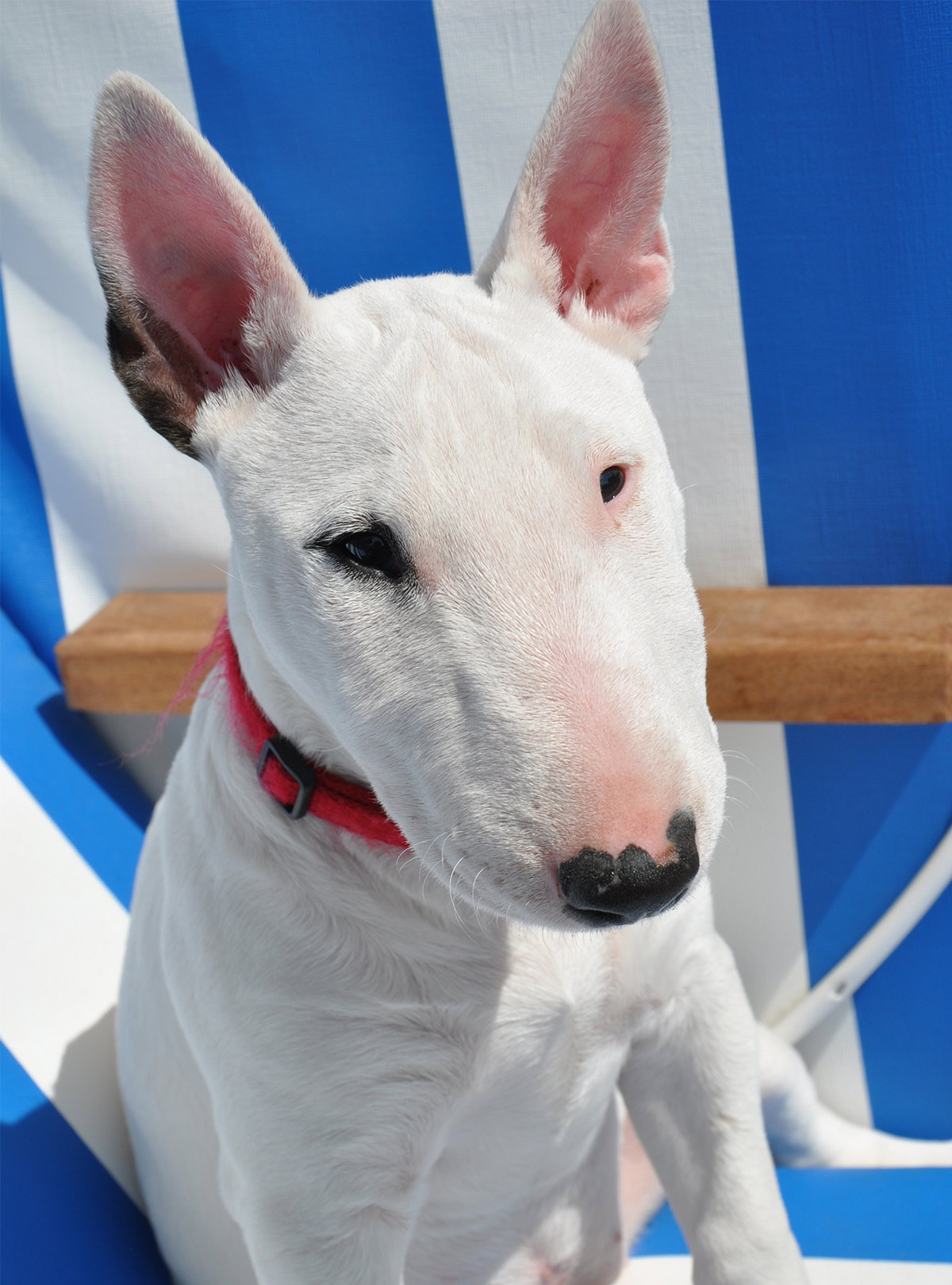
This Terrier sports a short coat that comes in a plethora of colors and is considered to be low maintenance. Bull Terriers have issues with heart murmurs, congenital deafness, and patella luxation. The average Bull Terrier hovers right around 21 to 22 inches tall, and weighs from 50 to 70 pounds. Bull Terriers have an average lifespan of 12 to 13 years.
A Bull Terrier Lab mix could display any of these traits, or any of those of a Lab. They will range somewhere in size between the two as adults. What you can be sure of is that this mix will need human company for most of the day, and thorough socialization from puppyhood. You can find out more about the Bull terrier here.
American Staffordshire Terrier Lab mix
The American Staffordshire Terrier Lab mix is also known as a Labrastaff. American Staffies are a very similar dog to the Pitbull Terrier. The American Staffordshire is a sturdy, medium size pooch described as an intelligent and self-assured dog. His agility and adaptability make him a natural for search and rescue duty.

The American Staffordshire has a sparkling personality that hardly ever dims, and she can be counted on to be a loyal friend. However there are concerns with these Pitbull related dogs about temperament. You can find out more about this in our article on the Pitbull Lab mix here.
The American Staffordshire Terrier is both muscular and agile and has an attractive form that is stocky in the front, tapering to an impressively lean backside. Moderate exercise is all that's needed to keep this friendly guy happy, although they can still excel at spots like agility and canicross.
American Staffordshire Terriers have a few medical conditions to be aware of. Hip dysplasia and heart disease are on the serious end of the spectrum. In addition immune system weaknesses can lead to allergies of the coat and skin. Luckily there are screening tests that can identify affected dogs as well as those carrying the gene responsible for the condition.
American Staffordshire dogs have a soft, short, easy-to-maintain coat that sheds minimally. American Staffordshire Terriers stand between 17 to 19 inches tall, and live 12 to 15 years on average.
Due to potential guarding instincts, you would need to socialize your puppy very carefully, especially to children and strangers coming into the home. It would also be important to meet the American Staffordshire Terrier parent, to get an idea of what temperament they may inherit. They are not the same breed as the Staffordshire Bull Terrier.
Staffordshire Bull Terrier Lab mix
The medium size Staffordshire Bull Terrier is built like a brick. Solid, heavy and strong. And at 14 to 16 inches tall, he is a bit smaller than his American Staffordshire brethren. This lively dog needs lots of exercise to burn up his considerable energy. And if he doesn't have a regular outlet his pent-up energy can turn destructive.
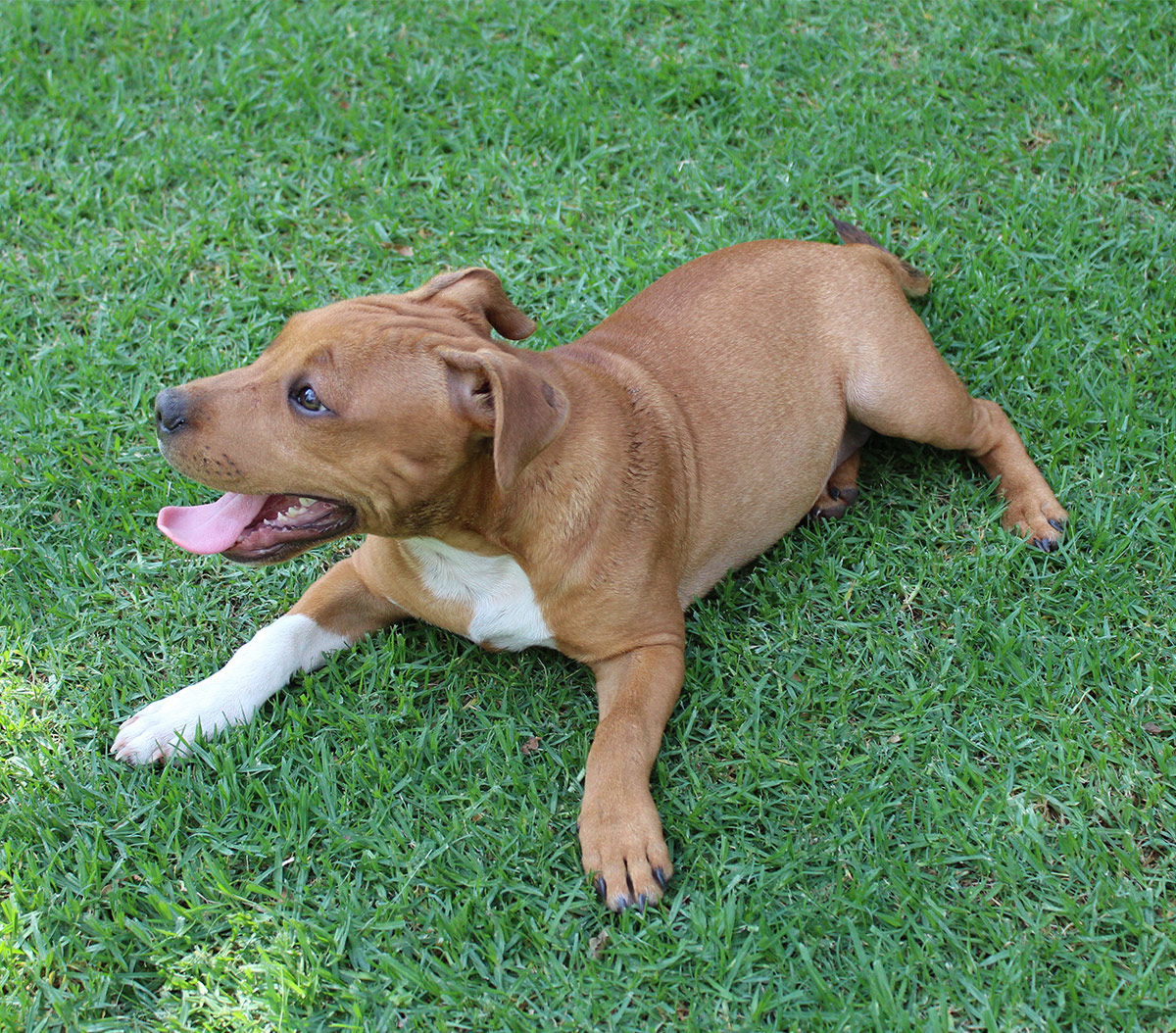
Traditional training may be an issue for the Staffordshire given his stubborn nature, so positive reinforcement training is advised. On the other hand, this smart dog can be gentle with children provided that supportive, early socialization and training is provided.
Staffordshires have a short, low-maintenance coat that comes in a rainbow of 14 colors. The Staffordshire Terrier stands approximately 14 to 16 inches tall and lives on average for 12 to 14 years. Males weigh between 28 and 38 pounds, with females a tad under that at 24 to 34 pounds.
A Lab mixed with a Staffie could display any of these tendencies. And will probably look like a shorter, stockier Lab with any number of potential color combinations. You can find out more about the Staffordshire Bull Terrier here.
Fox Terrier Lab mix
Smooth Fox Terriers and Wire Fox Terriers are different breeds within the Terrier dog type. Their fur and coloration, as well as head shape are two of the main differences between them.
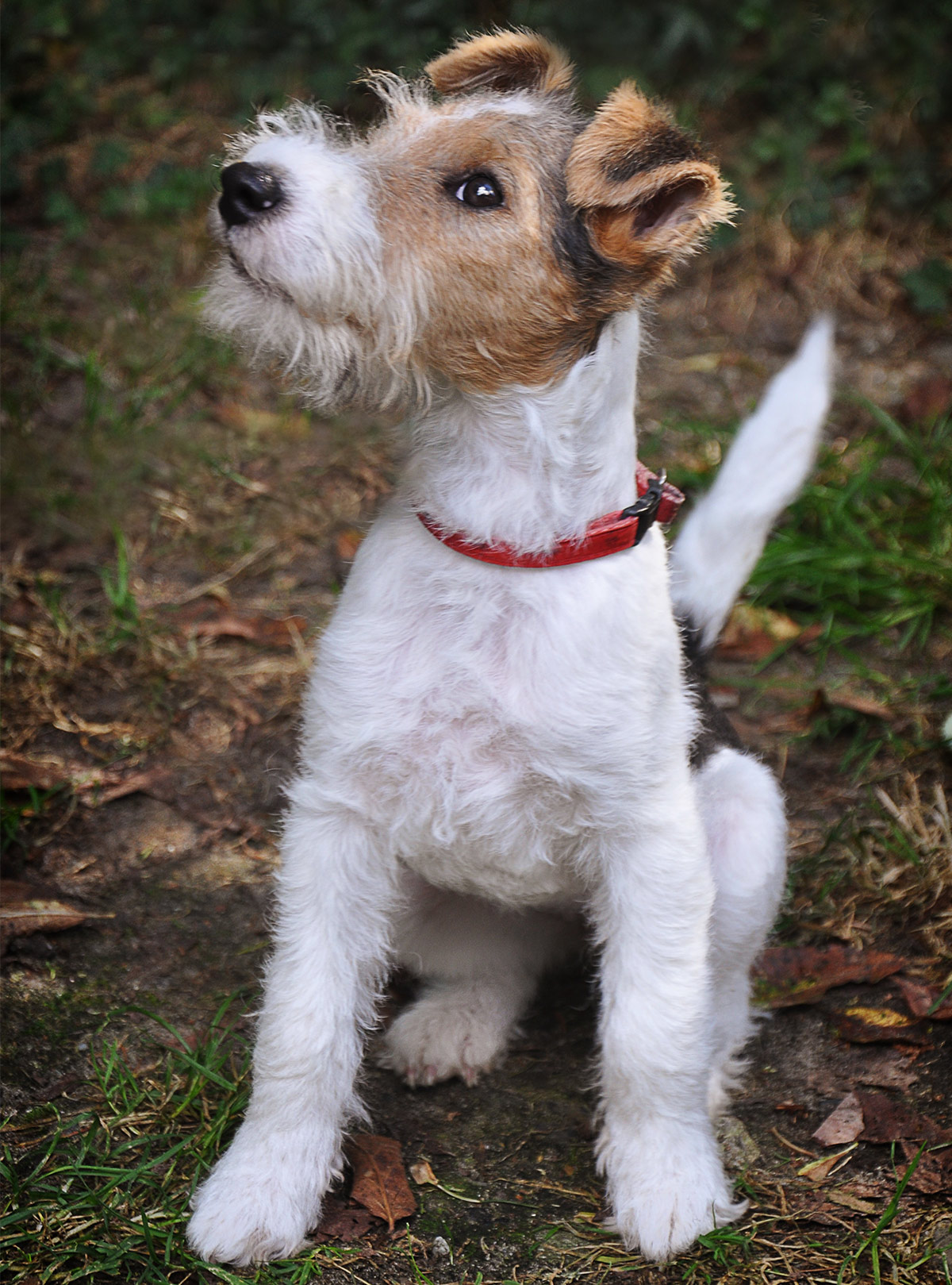
Smooth Fox Terriers are a medium size breed with an average level of energy. They average 15 inches tall and have a wedge shaped head. Their smooth, thick fur sheds seasonally. It is mainly white, with tan or black markings randomly decorating the coat. Although they have a short torso, these amazing animals have the grace of a gazelle.
Owners can expect their Smooth Fox Terriers to live an average of 12 to 15 years. The majority of these dogs are relatively healthy animals, although allergies and patellar luxation are typical issues.
The Wire Fox Terrier is named for his dense, springy low-shed coat. His wiry coat is predominantly white with brownish coloration about the ears and face. Health issues to be aware of include patellar luxation and deafness. This dog really, really, wants to be your BFF: he can never seem to get enough attention! The Wire Fox Terrier is always alert and spunky, ever ready to jump into playful action. This means that daily exercise and activity is a must.
Potential owners should also be aware that when their hunting DNA kicks in, Wire Fox Terrier pups are wont to run and chase moving objects that they shouldn't. Like cars, other animals, etc.
Like the Smooth Fox Terrier, the Wiry Fox Terrier is a medium size, medium energy dog who can be expected to live an average of 12 to 15 years. Males weigh an average of 18 pounds, while females average 16 pounds. Wiry Fox Terriers stand approximately 15 inches tall. You should prepare for your Lab Fox Terrier mix to potentially inherit his strong prey drive, and start recall training early.
Border Terrier Lab mix
The Border Terrier is a cheerful, agile little guy who stands anywhere between 11 to 16 inches tall. The cute little dog with the head shaped like an otter's has a dedicated work ethic and needs an exercise outlet to be happy. They have a typically short terrier-type coat, although it comes with wiry, not smooth fur. Dual color schemes on the coat include blue and tan and grizzle and tan.

The Border Terrier will do fine with children but can be tricky with other dogs. They are a relatively healthy group, although allergies can crop up. Border Terriers stand around a foot to 15 inches tall and live for 12 to 15 years on average. Males typically weigh 13 to 16 pounds, while females range from 11 to 14 pounds. Your Lab Border Terrier mix could inherit aspects from either parent, but is likely to be somewhere in between in terms of height. Find out more about the Border Terrier here.
Lab Terrier cross temperament
Knowing the kind of temperament a potential companion animal will bring to your home is crucial to forming a lasting bond. Too often dogs are surrendered because of incompatibility issues. A situation that could have been avoided with just a little research and a few well-placed questions.
Your Lab and Terrier mix will inherit her disposition from her parents. Will she be more like an affable Lab, eager to please and friendly almost to a fault? Or will she take on the spicier nature of the Terrier types? If so, your pup may be quite a handful, and may never learn to "play nice" with other dogs, even with training.
Then again, your pup may inherit the best (or worst) qualities of each breed, or she may be endowed with a mosaic of contrasting personality points. For some owners it is exciting to see a puppy's personality unfold and develop, for others, not so much.
Whatever camp you fall into, remember that there is no guarantee what sort of temperament your mixed breed dog will be blessed with. You must be happy with either temperament and the training requirements they could have, before you decide to commit to a Lab Terrier mix.
Lab Terrier mix – how big do they grow?
In the previous sections we've looked at the various Terrier dog dimensions including weight and height. Your cross breed will be within the ranges of his parents, depending on which Terrier and Lab are bred together.
So, how big do Labradors get? I'm glad you asked! Male Labs range from 22 to 25 inches tall, while females tend to average 21 to 24 inches in height. Likewise, males usually weigh more than females. A typical male Lab will range from 65 to 80 pounds and females typically weigh in between 55 to 70 pounds.
Terrier Lab mix general health
Allergies are common among the different types of Terriers. Allergic response occurs when the immune system reacts to common substances (allergens) as dangerous, resulting in an extreme physical response. Allergens can affect the respiratory and/or digestive systems as well as the skin. Dogs with allergic skin reaction are at risk for skin infection, hair loss, and scabbing.
We've listed the known health issues of the various Terrier types, so now let's take a look at the health issues that come along as part and parcel with the Labrador Retriever breed. Joint issues are at the top of the health issue list, including hip/elbow dysplasia and luxating patella (kneecap dislocation). Dysplasia occurs when a joint and its socket fail to align properly resulting in a painful grinding and rubbing motion versus a smooth movement. Unfortunately the outcomes of these disorders can include severe pain, distress, and loss of function for your pooch, as well as costly surgery.
Eye disease is also a concern with Labs. They are at risk for Canine Progressive Retinal Atrophy (PRA), a disorder that affects the retina and can lead to blindness. Cataracts pose another concern for Labs. Cataracts affect the eye lens by obstructing incoming light resulting in compromised vision.
The Labrador parent must be hip and elbow scored, PRA clear and have a clear eye test of less than a year old. The Terrier parent must be tested for any health conditions relevant to their breed too.
Lab Terrier hybrid lifespan
Labrador Retrievers have a life expectancy of approximately 12.5 years. Keeping in mind that a Lab and Terrier cross breed will enjoy the same approximate lifespan as it's parents, so let's revisit the various Terrier dog lifespans.
Most of the terrier breeds we've discussed live for 12 to 14 years on average. In general you can expect a healthy, well cared for mix breed pup to survive for around 10 years up to 12, and maybe a bit beyond. Smaller dogs and mixed breed dogs tend to live a little longer on average, so this gives your pup a good chance of a slightly increased time with you.
Lab Terrier mix breeders
If you are considering welcoming a Lab Terrier mix breed dog or puppy into your life, it's important to do your due diligence where health matters are concerned. Your mixed breed dog is at potential risk for any of the health issues that face her parents.
Health testing should be done for the issues that impact both parent breeds. Ask to see the parents' certificates proving that they were tested and cleared of hereditary diseases. In particular look for Labrador hip and elbow scores and eye tests.
Terrier Lab cross puppy
Working with a responsible breeder is one of the most important things that you can do to minimize unhappy surprises. This is as true for Black Lab Terrier mix puppies as it is for Terriers crossed with Chocolate and Yellow Labs.
Conscientious breeders will help you to learn what you need know about health issues. As well as ancillary concerns such as temperament, grooming, etc. For example, hip dysplasia is just one of the serious health issues which impact Labs and some Terriers.

In order to make an informed decision when choosing your pup, it is crucial to know as much as possible about the parent breeds' health conditions. And this is where a responsible, knowledgeable breeder comes in.
Remember, your mixed breed dog can inherit any aspect of either parent. So it makes sense to understand all health implications before making a lifelong commitment to a mix breed dog. Keep in mind that all puppies are individuals in their own right, and even littermates can exhibit vastly different traits.
Is a Labrador terrier mix right for my family?
If you're wondering if a Lab and Terrier cross breed dog will happily fit in to your home and with your lifestyle, here are a few considerations to ponder.
Labs are heavy shedders, with a moderate-plus need for exercise, and they have a reputation for chewing on the very things that owners don't want them to gnaw on! However, they will provide loyal and friendly companionship year after year.
Many Terriers can be a handful of live-wire energy, and in general they should be watched when in the company of other dogs. They like to be active and should not be considered a purse-dog or bought with the intention of having it be a lap-sitter.
Should I buy a Terrier Lab hybrid?
Your Black Lab Terrier mix, Yellow Lab Terrier mix, and Chocolate Lab Terrier mix has the potential to inherit these and other typical breed qualities from each parent. Are you prepared to handle and live with the characteristics that both Labs and Terriers bring to the table? Do the combined traits of the various Terriers and Labs sound like the ones you're looking for in a forever companion? If the answer is yes, the next step is to find a responsible breeder in your area, and begin the happy process of adopting a new four-legged forever friend!
Do you have a Lab and Terrier cross breed? We'd love to know more about your experiences with this unique animal, in the comments section below!
Further Reading
- Origins of the Labrador Retriever
- Dog breed groups explained
Sources
- Clements, D.N., et al, Dogslife: A web-based longitudinal study of Labrador Retriever health in the UK, BMC Veterinary Research, 2013
- Goldstein, O., et al, IQCB1 and PDE6B Mutations Cause Similar Early Onset Retinal Degenerations in Two Closely Related Terrier Dog Breeds, Investigative Ophthalmology & Visual Science, 2013
- LaFond, K., et al, Breed Susceptibility for Developmental Orthopedic Diseases in Dogs, Journal of the American Animal Hospital Association, 2002
- Robinson, D. A., et al, The Effect of Tibial Plateau Angle on Ground Reaction Forces 4–17 Months After Tibial Plateau Leveling Osteotomy in Labrador Retrievers, Veterinary Surgery, 2006
- Labrador Health
- The Border Terrier
- The Staffordshire Bull Terrier
- The Bull Terrier
- Labrador Pitbull Mix
- Staffordshire Terrier Club of America
- American Fox Terrier Club
- Bull Terrier Club of America

The Labrador Site Founder

Pippa Mattinson is the best selling author of The Happy Puppy Handbook, the Labrador Handbook, Choosing The Perfect Puppy, and Total Recall.
She is also the founder of the Gundog Trust and the Dogsnet Online Training Program
Pippa's online training courses were launched in 2019 and you can find the latest course dates on the Dogsnet website
How Big Does a Black Lab Terrier Mix Get
Source: https://www.thelabradorsite.com/lab-terrier-mix/